The Sarasota Ballet brings Ashton classics and 21st-century ballets to Jacob’s Pillow.
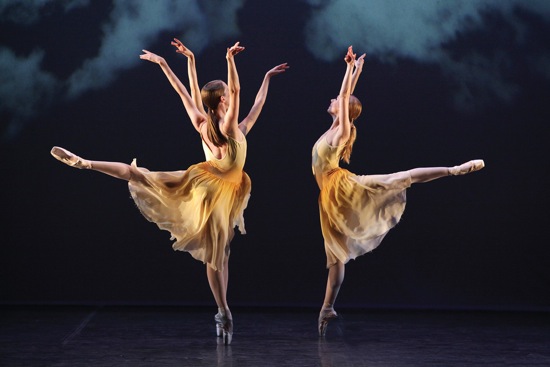
(L to R): Amy Wood, Christine Peixoto (hidden) and Victoria Hulland of The Sarasota Ballet in Christopher Wheeldon’s The American. Photo: Frank Atura
With art and culture kiting around in cyberspace and responding instantly to our keyboard-trained fingers, we are constantly jumping over boundaries. Crossing them in real time with tangible objects is another matter. Who would have imagined that The Sarasota Ballet would become a treasure house of over twenty ballets by the great 20th-century British choreographer Sir Frederick Ashton? Think of the balmy temperatures on the Gulf of Mexico, the keys with their sandy beaches; then think of often drizzly, foggy London where Ashton created his ballets.
Yet since 2007, when Iain Webb took over The Sarasota Ballet, Ashton has hit the beaches, so to speak. Webb had danced in Ashton’s works in Britain’s Royal Ballet and then in the Sadlers Wells Royal Ballet while the choreographer was still alive. In 2011, he was joined by his wife, Margaret Barbieri, a former principal dancer with the Royal—one on whom Ashton had created roles. She became The Sarasota Ballet’s Assistant Director and has staged his ballets for a number of companies.
Sarasota is justifiably proud of its ballet company, and the opening-night audience at the ensemble’s Jacob’s Pillow debut in early August was teeming with Sarasotans delighted to cheer for what has become one of the city’s cultural icons. Webb and Barbieri, however, know that no ballet company can live entirely in the past, no matter how burnished its performances. Therefore, at the Pillow, Ashton’s Monotones I and Monotones II were bookended by Christopher Wheeldon’s The American (2001) and a world premiere: In A State of Weighlessness by Ricardo Graziano, a principal dancer in the company as well as its resident choreographer.
All three works showed that one of The Sarasota Ballet’s treasures is its beautifully disciplined dancers; since all three ballets were double cast, twenty-three company members were on view. Disciplined is a word used to praise a dancer, but it can also conjure up a vision not just of accuracy and skill, but of a dutifulness that can border on stiffness. That’s not the case with the highly skilled members of this company. They dance with fluency and musicality. Their focus takes in the space and one another. They neither exaggerate nor underplay the movement.
None of the three ballets has a story. Each, however, creates a different atmosphere. Wheeldon made The American for the Carolina Ballet the same year that he choreographed Polyphonia for the New York City Ballet, and while The American is the lesser of the two, it is nevertheless finely made and very charming. Wheeldon drew his title from the sobriquet bestowed on the music: Antonin Dvorak’s Quartet No. 12, Op. 96. Dvorak had composed it in short order during an 1893 summer vacation in Spillville, Iowa (a tiny town with a sizeable Czech population). Listening to it, you may think you can detect a trace of an American folk melody here and there, but any such are splintered and well hidden.
What Wheeldon fastened on was a kind of breeziness in the melodic, sweet-tempered music— here a balmy zephyr, here a bit of turbulence. In addition, he introduced a sense of community through the ballet’s designs in space. Often various of the eight dancers, or all of them, form a circle, traveling around its perimeter, or move in and out of its center like the spokes of a wheel. At moments in the frisky final movement, the performers briefly place their hands on their hips, folk-dance style.
This is a dance as mobile as the women’s filmy skirts and the men’s full-sleeved shirts, and the swirling steps and rushes on and off the stage suggest that people are blown in and out of this party, which pairs six women and six men. Aaron Muhl’s lighting changes the atmosphere in ways that alter the weather and time of day with a certain willfulness—now a soft “sun” glows on the backdrop, now a blue sky with clouds appears, now a moon, now bright sun; at the end the backdrop turns entirely orange.
Although the women (or some of them) dance together briefly, as do the men, Wheeldon shows off couples. There are a great many lifts; men carry women offstage high overhead and arched back in abandon, or—also held high—bending forward to hover over their partners. I think of the Rape of the Sabine Women, but these women look pleased with everything, even when they’re rolled along the floor. Many imaginative moments and patterns emerge, and the dancers attack the movement with a freshness that’s very beguiling. Principal dancers Danielle Brown and Ricardo Rhodes establish a romantic relationship, as do Amy Wood and Graziano and, more briefly, others. There’s not an unkind moment in this ballet.
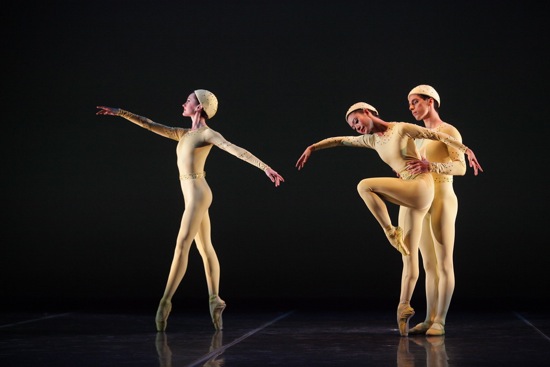
(L to R): Samantha Benoit, Ryoko Sadoshima, and Alex Harrison in Frederick Ashton’s Monotones I. Photo: Frank Atura
I have always thought of the three people in Ashton’s Monotones I (1966) and the three in Monotones II (1965) as extraterrestrial saltimbanques, acrobats from another world. I say this even though Ashton has said that he thought of Monotones I as “earth” and Monotones II as moonlit (“lunaire” was his word). The performers’ subtly glinting, gender-erasing unitards (very pale yellow for the first, white for the second) and the helmet-like caps that conceal their hair add to their otherworldly look. Staying almost always close together, the trios in each exquisite little ballet seem like organisms that function as a unit, with the dancers travelling together hand in hand, doing identical steps in close proximity, or working into intricate, but crystal-clear interlacings.
Their decorum is classical; they lift their arms into port de bras that might have come out of a ballet class, twist their torsos as if to show the lexicon of épaulements. All is done quietly and seriously. Like triplets in art, they raise their legs in arabesque to exactly the same height.
The twinned ballets are danced to orchestrated versions of Erik Satie’s music for piano— Monotones I to his Gnossiennes, Nos. 1, 2, and 3, Monotones II to his Gymnopedies, Nos. 1, 2, and 3. Music delicate and dreamy, yet insistent. Ashton choreographed a trio of two women and a man for the first and a trio of two men and a woman for the second. The dancers in Monotones I (Ryoki Sadoshima, Samantha Benoit, and Alex Harrison) begin in a line that stretches away from the audience—their initial arabesques sparking out of that slim line in alternating directions. Harrison also cartwheels each of the women. Their every move is clearly etched, executed without haste, yet they move fluidly. They jump briefly—hand in hand and not high. During the second of Satie’s pieces, they separate and cover ground, but it’s as if they were being washed gently back and forth in differing tides. When Harrison lifts one of the women, the other runs around the two of them—close, but not touching.
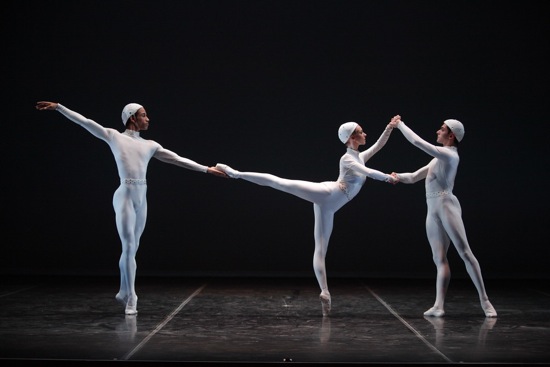
(L to R): Ricardo Rhodes, Victoria Hulland, and Francisco Graziano in Frederick Ashton’s Monotones II. Photo: Gene Schiavone
The more celebrated Monotones II opens with an uncanny image, performed coolly. When the lights come on, Victoria Hulland is lying on the floor face down, and when Rhodes and Graziano bend down and set her upright, she is already in a position—standing on one pointe shoe and holding her other leg so high that it is in front of her face. While she remains that way, the two men collaborate in gravely turning and dipping her forward and returning her to her erect stance between them. They do this several times, and she never lets go of her leg. During this pas de trois, Ashton shows this extreme and difficult-to-maintain position of the ballerina in other ways—tipped upside down, passed through on the way to something else.
Yet—and this is an interesting contrast—the woman, despite being manipulated by the two men as if she were an automaton they were testing, is gracious, even affectionate; after she first lets go of that lifted leg, she steps into arabesque, leaning affectionately toward one of them, then the other. At other times, the three are equals, presenting the same polished steps side by side or fitting their bodies together to create a joint sculpture. When one man holds Hulland in a balance, the other imitates her pose without any support but his own strength. Near the end, she bourrées backward upstage, holding her arms high and curving them to link with those of Rhodes and Graziano; they advance upstage with her in deep lunging steps (their backs to the audience). You can’t be sure whether she is leading and supporting them or vice versa.
The arduousness of these two trios allied with their preternatural calm gives them a curious beauty. Who are these creatures, so single-mindedly knitting themselves into patterns?
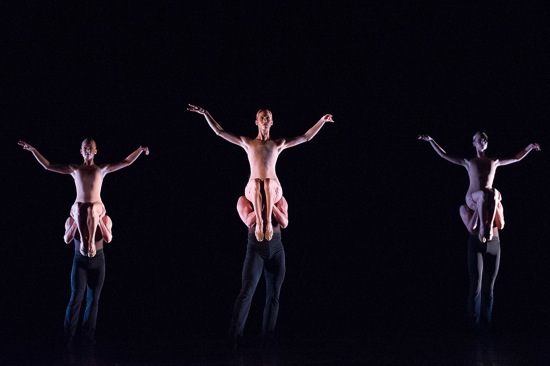
The opening image in The Sarasota Ballet’s premiere of Ricardo Graziano’s In A State of Weightlessness. Photo: Christopher Duggan
Graziano’s In A State of Weightlessnesss makes me wonder about the title. Does it refer to the many lifts of women by men? Or has it something to do with the music and the quality of the dance? Graziano has set his ballet to the second movement of Philip Glass’s Tirol Concerto for Piano and Orchestra. The lush music does at the outset seem to hover above the stage, as Glass establishes and plays with his intial five-note melody, but the piece acquires density and urgency as it progresses, then descends into a prolonged sort of amen. Graziano doesn’t acknowledge some of the textural changes in the music and its speedy undercurrents that erupt and die away. His choreography, often very intriguing, seems to progress on its own terms at a fairly even pace, so the dance seems longer than its fifteen or so minutes.
The black curtain is drawn at the back of the Ted Shawn Theater’s stage, making the dancers appear to be in kind of limbo, and, as in Wheeldon’s ballet, couples are the focus. One of the most striking things about In A State of Weightlessnesss is its inititial image. Three (or was it four?) women are held up by men in a prim position, as if seated on chairs. Only the men’s legs and supporting arms are visible. This image recurs a number of times. Sometimes it is inverted; once a woman manages to assume the position facing her partner as he lifts her. From this starting position, the women can open their legs wide as they’re carried across the stage, then bend them into a diamond shape that makes me, for some reason, think of frogs. The men also carry their partners overhead, with the women lying stiffly on their sides like dolls.
Graziano, who joined the company in 2010 and choreographed his first ballet the following year, knows these dancers well. Performing among them, while creating five more works has been crucial to his education. So as pairs come and go, join and separate during In A State of Weightlessness, he gives you plenty of time to admire their technical skills, full-bodied dancing, and gracious, modest decorum. In the cast I saw, they were (per program listing) Kristianne Kleine and Rhodes, Brown and Justin Gil, Nicole Padilla and Harrison, Hulland and Daniel Rodriguez, Elizabeth Sykes and Logan Learned—all of them a pleasure to watch.

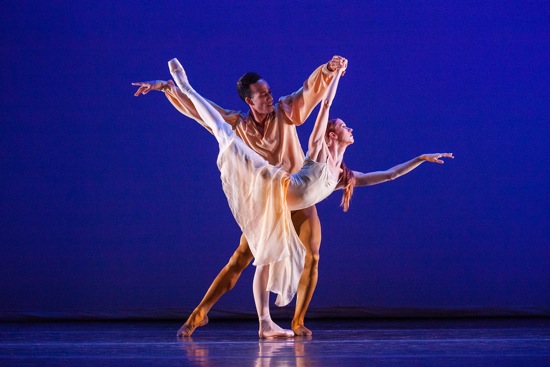
I normally don’t read reviews; but since I now live in Sarasota, I was curious when I saw that you had reviewed the company…and for me..your review is a classic example of a ballet review…In other words, it was a pleasure to read…..thank you….
Whenever Deborah Jowitt writes I am impressed with her insight and reflection.
She is the best dance critic today.
I couldn’t go to Jacob’s Pillow but wish I could have – but Deborah gave her view and I enjoyed reading
it thoroughly.